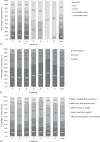Hand hygiene compliance in companion animal clinics and practices in Switzerland: An observational study
- PMID: 33870536
- PMCID: PMC8250537
- DOI: 10.1002/vetr.307
Hand hygiene compliance in companion animal clinics and practices in Switzerland: An observational study
Abstract
Background: Hand hygiene (HH) is one of the most important measures to prevent healthcare-associated infections. Data on HH compliance in companion animal veterinary institutions in Europe are sparse.
Methods: This observational study assessed HH according to WHO standards in three large and two medium-sized clinics and two primary care practices in Switzerland. Associations with HH indication, professional group, clinical area and institution were determined using a generalized linear mixed effects model.
Results: Based on 2056 observations, overall HH compliance [95% confidence interval] was 32% [30%-34%]. HH compliance was highest in the consultation area (41% [38%-45%]) and after contact to body fluids (45% [40%-50%]), and lowest in the pre-OR area (20% [15%-24%]) and before clean/aseptic procedures (12% [9%-15%]). Veterinarians showed a higher HH compliance (37% [34%-40%]) than veterinary nurses (25% [22%-28%]). HH compliance was lower before clean/aseptic procedures compared to all other indications (all p < 0.015 except 'before touching a patient' in medium-sized clinics/practices, p = 0.095) and higher in the consultation area compared to all other areas in large clinics (all p < 0.04).
Conclusion: Effective HH training should urgently be promoted for all veterinary personnel with special emphasis on the importance of HH before clean/aseptic procedures.
© 2021 British Veterinary Association.
Figures



Comment in
-
Improving hand hygiene standards in the veterinary setting.Vet Rec. 2021 Jul;189(1):29-31. doi: 10.1002/vetr.702. Vet Rec. 2021. PMID: 34241866 No abstract available.
References
-
- World Health Organization . WHO guidelines on hand hygiene in health care: a summary. First global patient safety challenge clean care is safer care. 2009. https://www.who.int/gpsc/5may/tools/who_guidelines-handhygiene_summary.pdf. Accessed 8 July 2020. - PubMed
-
- Allegranzi B, Pittet D. Role of hand hygiene in healthcare‐associated infection prevention. J Hosp Infect. 2009;73:305–15. - PubMed
-
- Pittet D, Boyce JM. Hand hygiene and patient care: pursuing the Semmelweis legacy. 2001. Lancet Infect Dis. 2001;1:9–20. - PubMed
-
- Canadian Committee on Antibiotic Resistance . Infection prevention and control best practices for small animal veterinary clinics. 2008. https://www.wormsandgermsblog.com/files/2008/04/CCAR-Guidelines-Final2.pdf. Accessed 8 July 2020.
-
- Sax H, Allegranzi B, Uçkay I, Larson E, Boyce J, Pittet D. ‘My five moments for hand hygiene': a user‐centred design approach to understand, train, monitor and report hand hygiene. J Hosp Infect. 2007;67:9–21. - PubMed
Publication types
MeSH terms
LinkOut - more resources
Full Text Sources
Other Literature Sources
Medical

